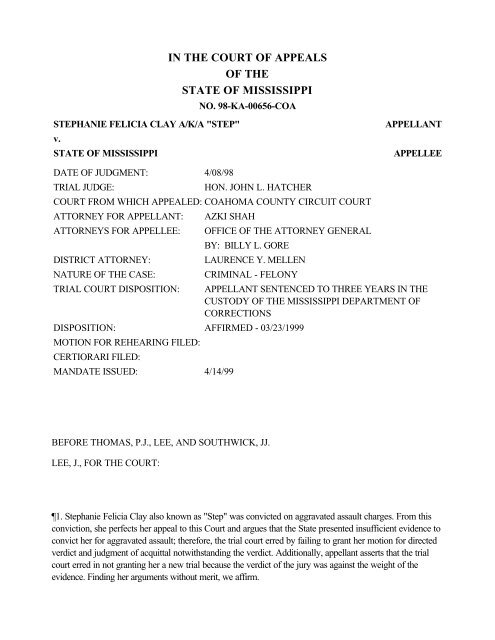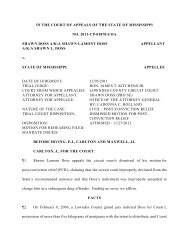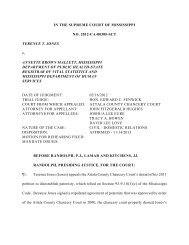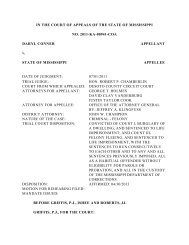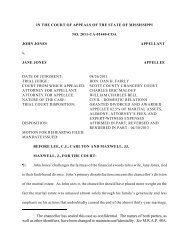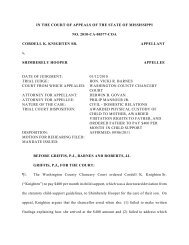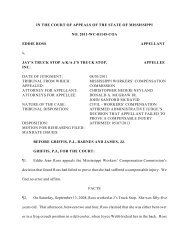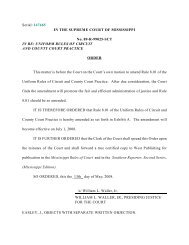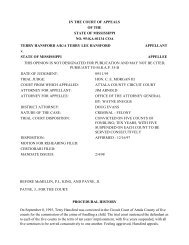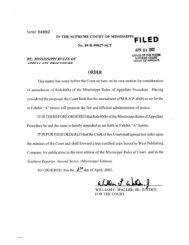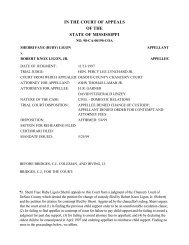98-KA-00656-COA - Mississippi Supreme Court
98-KA-00656-COA - Mississippi Supreme Court
98-KA-00656-COA - Mississippi Supreme Court
You also want an ePaper? Increase the reach of your titles
YUMPU automatically turns print PDFs into web optimized ePapers that Google loves.
IN THE COURT OF APPEALS<br />
OF THE<br />
STATE OF MISSISSIPPI<br />
NO. <strong>98</strong>-<strong>KA</strong>-<strong>00656</strong>-<strong>COA</strong><br />
STEPHANIE FELICIA CLAY A/K/A "STEP"<br />
v.<br />
STATE OF MISSISSIPPI<br />
APPELLANT<br />
APPELLEE<br />
DATE OF JUDGMENT: 4/08/<strong>98</strong><br />
TRIAL JUDGE:<br />
HON. JOHN L. HATCHER<br />
COURT FROM WHICH APPEALED: <strong>COA</strong>HOMA COUNTY CIRCUIT COURT<br />
ATTORNEY FOR APPELLANT:<br />
ATTORNEYS FOR APPELLEE:<br />
DISTRICT ATTORNEY:<br />
NATURE OF THE CASE:<br />
TRIAL COURT DISPOSITION:<br />
AZKI SHAH<br />
OFFICE OF THE ATTORNEY GENERAL<br />
BY: BILLY L. GORE<br />
LAURENCE Y. MELLEN<br />
CRIMINAL - FELONY<br />
DISPOSITION: AFFIRMED - 03/23/1999<br />
MOTION FOR REHEARING FILED:<br />
CERTIORARI FILED:<br />
MANDATE ISSUED: 4/14/99<br />
APPELLANT SENTENCED TO THREE YEARS IN THE<br />
CUSTODY OF THE MISSISSIPPI DEPARTMENT OF<br />
CORRECTIONS<br />
BEFORE THOMAS, P.J., LEE, AND SOUTHWICK, JJ.<br />
LEE, J., FOR THE COURT:<br />
1. Stephanie Felicia Clay also known as "Step" was convicted on aggravated assault charges. From this<br />
conviction, she perfects her appeal to this <strong>Court</strong> and argues that the State presented insufficient evidence to<br />
convict her for aggravated assault; therefore, the trial court erred by failing to grant her motion for directed<br />
verdict and judgment of acquittal notwithstanding the verdict. Additionally, appellant asserts that the trial<br />
court erred in not granting her a new trial because the verdict of the jury was against the weight of the<br />
evidence. Finding her arguments without merit, we affirm.
FACTS<br />
2. On the evening of June 28, 1996, the Renaissance Lounge had attracted a sizeable gathering for a night<br />
of socializing and dancing. Two of the individuals present at this gathering were Herman Jackson, III and<br />
Stephanie Clay, the appellant in this case. Trial testimony reflected that Herman Jackson was dancing on the<br />
dance floor of the club when several boys gathered around Jackson and appeared to be mocking his<br />
dancing. Shortly thereafter, an altercation ensued among the aforementioned boys and Jackson. Stephanie<br />
Clay soon joined in the dance floor chaos and started fighting with Herman Jackson.<br />
3. Several police officers at the scene witnessed Stephanie Clay and Herman Jackson involved in an<br />
altercation. Trial testimony reflected that it required the assistance of police officers to separate Clay and<br />
Jackson from one another to terminate the fighting taking place between them.<br />
4. During the altercation between Stephanie Clay and Herman Jackson, Herman Jackson stated he had<br />
thrown Stephanie Clay to the floor. When Stephanie Clay got off the floor, she raised her hand as if she<br />
were going to strike Jackson. Jackson made an attempt to block Stephanie Clay's strike with his hand, and<br />
Herman Jackson stated it was then that Stephanie Clay stabbed him. A bloody knife was discovered by<br />
officers in close proximity to the area in which the altercation took place between Stephanie Clay and<br />
Jackson.<br />
5. At trial, there was a witness who testified he had observed Stephanie Clay approximately an hour<br />
before the altercation in question, and that Stephanie Clay was displaying two knives and he had overheard<br />
her make the statement "if a mother 'F-er' 'F' with her tonight, she going to kill her a 'B'." The same witness<br />
also testified that he had observed the dance floor altercation between Stephanie Clay and Jackson and had<br />
witnessed Stephanie Clay stab Jackson with the knife. Furthermore, Herman Jackson took the stand and<br />
identified Stephanie Clay as his dance floor assailant.<br />
6. Stephanie Clay testified at her trial stating that she did not stab Herman Jackson. Additionally, she<br />
testified it was another individual who had reached over her shoulder who stabbed Jackson; however, she<br />
did not see and could not identify the individual which she alleged stabbed Jackson. Stephanie Clay further<br />
testified that it was her twelve year old sister Magnolia Clay who was fighting Herman Jackson and she had<br />
merely intervened to help her sister. Magnolia Clay testified that she had fought with Jackson and that her<br />
sister did not stab Jackson; however, Magnolia had been sprayed with mace by a police officer prior to the<br />
stabbing and was admittedly both visually impaired and not in the presence of her sister, Stephanie, and<br />
Jackson when the stabbing occurred. Magnolia Clay did not present this version of the night's events until<br />
the day of the trial and several officers testified that it was only Stephanie Clay they witnessed fighting<br />
Jackson and whom they separated from Jackson on the night in question.<br />
DISCUSSION<br />
I. WHETHER THE TRIAL COURT ERRED BY REFUSING TO GRANT THE APPELLANT'S<br />
REQUESTS FOR A DIRECTED VERDICT AND/OR JUDGMENT NOTWITHSTANDING<br />
THE VERDICT.<br />
7. The first assignment of error is that the trial court erred when it did not grant appellant's motion for a<br />
directed verdict at the close of appellant's case-in-chief, as well as, failing to grant the motion for judgment<br />
of acquittal notwithstanding the verdict. "Requests for a directed verdict and motions JNOV implicate
sufficiency of the evidence." Franklin v. State, 676 So. 2d 287, 288 (Miss. 1996). Appellant argues that<br />
there was insufficient evidence presented by the State to support a conviction of aggravated assault.<br />
8. When the trial court judges the legal sufficiency, as opposed to the weight of the evidence on a motion<br />
for a directed verdict, the trial court is required to consider evidence introduced in the light most favorable<br />
to the State and accept as true all of the evidence introduced at trial by the State, including all reasonable<br />
inferences that may be drawn therefrom. Yates v. State, 685 So. 2d 715, 718 (Miss. 1996) (citations<br />
omitted). Any evidence that is favorable to the defendant must be disregarded during the consideration of<br />
the trial court in determining whether to grant a motion. Id. at 718. (citations omitted).<br />
9. When the court is making a determination on whether to grant a judgment notwithstanding the verdict,<br />
the court is "not at liberty to direct that the defendant be discharged short of a conclusion . . . that given the<br />
evidence, taken in the light most favorable to the verdict, no reasonable hypothetical juror could find beyond<br />
a reasonable doubt that the defendant was guilty." Hicks v. State, 580 So. 2d 1302, 1304-05 (Miss.<br />
1991) (quoting Pearson v. State, 428 So. 2d 1361, 1364 (Miss. 1<strong>98</strong>3)). Additionally, in Hicks v. State,<br />
580 So. 2d 1302, 1305 (Miss. 1991), the <strong>Mississippi</strong> <strong>Supreme</strong> <strong>Court</strong> quoted from McFee v. State, 511<br />
So. 2d 130, 133-34 (Miss. 1<strong>98</strong>7), to repeat the standard which we as an appellate court are to apply in<br />
resolving the issue of whether the evidence is sufficient to sustain the jury's verdict:<br />
When on appeal one convicted of a criminal offense challenges the legal sufficiency of the evidence,<br />
our authority to interfere with the jury's verdict is quite limited. We proceed by considering all of the<br />
evidence -- not just that supporting the case for the prosecution -- in the light most consistent with the<br />
verdict. We give the prosecution the benefit of all favorable inferences that may reasonably be drawn<br />
from the evidence. If the facts and inferences so considered point in favor of the accused with<br />
sufficient force that reasonable men could not have found beyond a reasonable doubt that he was<br />
guilty, reversal and discharge are required. On the other hand, if there is in the record substantial<br />
evidence of such quality and weight that, having in mind the beyond a reasonable doubt burden of<br />
proof standard, reasonable and fair minded jurors in the exercise of impartial judgment might have<br />
reached different conclusions, the verdict of guilty is thus placed beyond our authority to disturb.<br />
(citations omitted).<br />
10. Under § 97-3-7 of the <strong>Mississippi</strong> Code Annotated (Supp. 19<strong>98</strong>), a person may be found guilty of<br />
aggravated assault if the State proves one of the following:<br />
A person is guilty of aggravated assault if he (a) attempts to cause serious bodily injury to another, or<br />
causes such injury purposely, knowingly or recklessly under circumstances manifesting extreme<br />
indifference to the value of human life; or (b) attempts to cause or purposely or knowingly causes<br />
bodily injury to another with a deadly weapon or other means likely to produce death or serious<br />
bodily harm . . . .<br />
11. At trial, a witness testified that prior to the altercation between Stephanie Clay and Herman Jackson he<br />
had observed Clay with two knives. One of the knives looked like a kitchen knife and the other knife was<br />
hooked, like a work knife. Additionally, the witness testified he had overheard Clay make the statement "if<br />
a mother 'F-er' 'F' with her tonight, she going to kill her a 'B'." The witness went on to explain that he was<br />
present at the Renaissance Lounge and witnessed Stephanie Clay stab Herman Jackson. Furthermore,<br />
Herman Jackson identified Stephanie Clay as his assailant. To reinforce Jackson's testimony there was the<br />
testimony of several officers who stated they witnessed Stephanie Clay and Jackson in an altercation. One
officer testified that he had to remove Stephanie Clay from Jackson to stop her attack on Jackson.<br />
Furthermore, an officer testified that shortly after the altercation between Clay and Jackson had been<br />
terminated, a bloody knife was found in close proximity to the area in which the altercation had taken place.<br />
12. In Rainer v. State, 438 So. 2d 290, 292 (Miss. 1<strong>98</strong>3), the appellant brought into issue the failure of<br />
the trial court to grant his motions for a directed verdict and judgment of acquittal notwithstanding the<br />
verdict. Rainer claimed that the State had failed to prove his guilt beyond a reasonable doubt. Rainer argued<br />
that the testimony of certain witnesses needed to have been viewed with great caution because of ulterior<br />
motives and the fact that their trial testimony was contradictory to earlier statements given to police officers.<br />
Id. at 292. Circumstances in this case are similar to Rainer. The defense tried to devalue the credibility of<br />
witnesses' testimony by showing contradictions in their testimony as opposed to earlier statements given to a<br />
police officer. Additionally, without success, the defense tried to prove that there might have been ill feelings<br />
among the witnesses and Stephanie Clay. Although evidence in a case may be slim, the <strong>Court</strong> must accept<br />
all reasonable inferences as true when it reviews the sufficiency of the evidence. Rainer, at 292. A trial<br />
judge can take the case from the jury only where there is no testimony that would warrant the jury, if the<br />
witness were believed, in finding a verdict. Price v. State, 207 Miss. 111, 41 So. 2d 37, 40 (1949).<br />
13. Considering all of the evidence in the record and giving the prosecution the benefit of all favorable<br />
inferences that may reasonably be drawn from the evidence, and if all the aforementioned evidence is taken<br />
as true, reasonable men could have found that Stephanie Clay was guilty of aggravated assault.<br />
Accordingly, this assignment of error is without merit.<br />
II. WHETHER THE JUDGE ABUSED HIS DISCRETION BY NOT GRANTING A NEW<br />
TRIAL.<br />
14. The second assignment of error is that the court erred when it did not grant the appellant a new trial.<br />
Appellant claims that the new trial should have been granted because the verdict was against the<br />
overwhelming weight of the evidence. In Benson v. State, 551 So. 2d 188, 193 (Miss. 1<strong>98</strong>9), the<br />
<strong>Mississippi</strong> <strong>Supreme</strong> <strong>Court</strong> provided the following explanation of when it would grant a new trial:<br />
This <strong>Court</strong> will not order a new trial "unless convinced that the verdict is so contrary to the<br />
overwhelming weight of the evidence that, to allow it to stand, would be to sanction an<br />
unconscionable injustice." Groseclose v. State, 440 So. 2d 297, 300 (Miss. 1<strong>98</strong>3). Factual disputes<br />
are properly resolved by the jury and do not mandate a new trial. Temple v. State, 4<strong>98</strong> So. 2d 379,<br />
382 (Miss. 1<strong>98</strong>6).<br />
We have often stated that issues regarding the weight and credibility of evidence lie with the jury. Eakes v.<br />
State, 665 So. 2d 852, 872 (Miss. 1995). We will reverse only where the evidence, as to at least one of<br />
the elements of the crime charged, is such that a reasonable and fair minded juror could not find the accused<br />
guilty. Id. In determining whether a jury verdict is against the overwhelming weight of the evidence, this<br />
<strong>Court</strong> accepts as true all evidence which supports the verdict and will reverse only when convinced that the<br />
trial court has abused its discretion in failing to grant a new trial. Id.<br />
15. The facts in this case reflect factual differences in the version of the occurrence of the night's events as<br />
told by prosecution and defense witnesses and these discrepancies were properly resolved by the jury as<br />
fact finder because questions regarding weight and worth of witness testimony or witness credibility are for<br />
the jury to settle. Eakes v. State, 665 So. 2d 852, 872 (Miss. 1995).
16. Accepting the evidence as true, as we are required to do, a review of the record reveals that the jury's<br />
verdict was not against the "overwhelming weight of the evidence" and to allow the jury's verdict to stand<br />
would not result in an "unconscionable injustice." We do not think the trial court abused its discretion in<br />
failing to grant a new trial. We, therefore, find no reversible error by the trial court.<br />
17. THE JUDGMENT OF THE CIRCUIT COURT OF <strong>COA</strong>HOMA COUNTY OF<br />
CONVICTION FOR AGGRAVATED ASSAULT AND SENTENCE OF EIGHT YEARS IN<br />
THE CUSTODY OF THE MISSISSIPPI DEPARTMENT OF CORRECTIONS, WITH FIVE<br />
YEARS SUSPENDED AFTER THE DEFENDANT HAS SERVED THREE YEARS IS<br />
AFFIRMED. ALL COSTS OF THIS APPEAL ARE ASSESSED TO <strong>COA</strong>HOMA COUNTY.<br />
McMILLIN, C.J., KING AND SOUTHWICK, P.JJ., BRIDGES, COLEMAN, DIAZ, IRVING,<br />
PAYNE, AND THOMAS, JJ., CONCUR.


